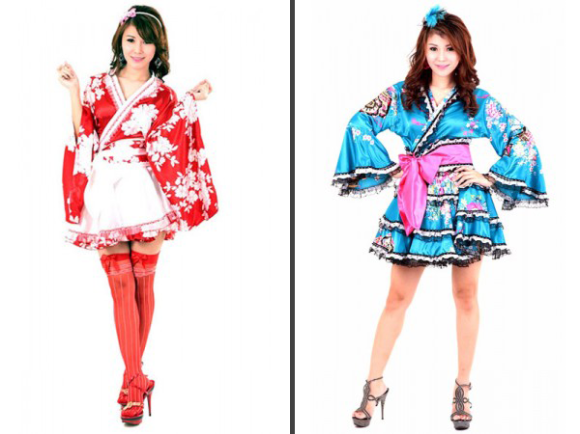
Summer is the season for festivals here in Japan. Every weekend some district or other is putting together a party for locals and tourists to come and enjoy. There are food stands, game stalls, temporary toy shops, and people all around. Most come with a parade event of sorts and end with an explosion of amazing fireworks. But above all, something you’re always going to find at any self-respecting festival are people dressed traditionally in lightweight yukata (a summer kimono) and jinbei (robe-style shirt and shorts) as they wander the streets.
But what about in Western counties like America? In early September of every year, Saint Louis, Missouri, holds a large Japanese-style festival in the city’s botanical gardens. Despite the lingering heat of late summer, somewhere between 20 to 30 thousand people attend this great cultural event each year. But what do they wear? Judging by the array of kimono and yukata available at the English shopping site A Fashion, people hoping to model some Japanese styles might find themselves in what resembles a crazy costume more than actual clothes.
Here in Japan, it is perfectly common for men and women to go about their daily lives wearing what we now consider traditional Japanese clothing. One can often find women dressed in full kimono sitting between suited businessmen on the trains. Girls might wear yukata to attract attention at a summer concert, and men might wear jinbei when lounging around the house. Just because these things are traditional does not mean they are outdated, and you would be hard-pressed to find a Japanese person who is unfamiliar with the style and fit of such clothing.
Most Westerners, however, do not share that easy familiarity with Japanese styles. Why, you could paint some bamboo on a bath robe, call it a kimono, and many of my fellow Americans would be none the wiser. Sure, that might sound a bit harsh, but let’s look at some of the fundamental differences between what Japanese people call a kimono and what’s being marketed to Westerners under the same name.
▼ The picture on the left comes from A Fashion, and the one on the right from Japanese shopping site Kimono Ichiba.
At first glance, these two pieces might seem quite similar, but fundamentally speaking, they are entirely different. Look closely at the waist, and you’ll see it. The Westernized green kimono is cinched at the waist and accentuates the woman’s curves. This is the exact opposite of traditional Japanese aesthetics, which focus on simplistic forms. Traditional kimono are meant to flatten out all of the planes of a woman’s body and to create a clean, cylindrical form.
This difference in aesthetics can also be seen in the choice of fabrics. The green kimono is very bright and features a loud pattern of starkly contrasting colors and very little cultural significance to the symbols. Traditional Japanese kimono, like the blue one here above, tend to favor paler colors and more subtle patterns. Then there is the matter of fabric. Fine kimono are usually made of 100-percent silk. Yukata, their summer counterparts, are generally made of cotton. However, the distinct shine on the kimono marketed to Westerners would suggest that they’re made of some sort of synthetic fiber, like polyester.
Of course, this does not mean that some clothing manufacturers in Japan haven’t modernized the kimono and given it a bit of extra flair. Many of the yukata sold to young women now have lace around the collar, and in certain specialty stores, one can find so-called kimono in the style of frilly Lolita dresses. However, there is a distinct difference between adjusting traditional styles to reflect modern aesthetics and just plain misinterpreting of the source. So what are we seeing here? Is this a case of Western ignorance or an intentional revision of Japanese garb? These examples should help you be a better judge.
▼ I’d give these two more credit if they weren’t inviting such bad luck upon themselves. Folding the right side of a kimono over top of the left is a style reserved only for the dead and the too-drunk-to-notice…
▼ This is my first time seeing a kimono with flared sleeves and layered skirts, though I image the apron variety has a place in some maid cafes.
▼ Now, I can’t help but feel that an asymmetrical hemline is the exact opposite of simplistic forms. And is that a kimono or some kinky lingerie?
Oh well, whatever it takes to stay cool during the summer, I suppose!
Source: Nikkei Trendy (Japanese)
Pictures: A Fashion

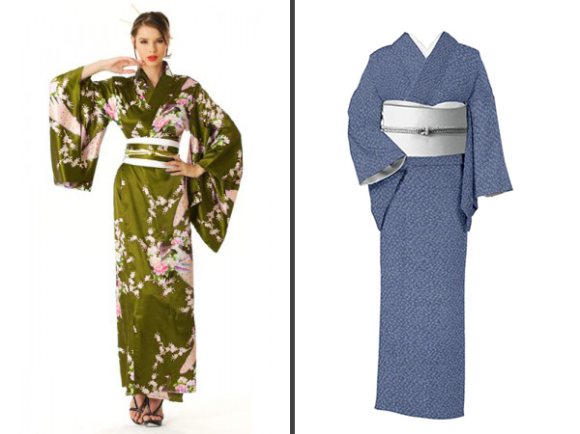
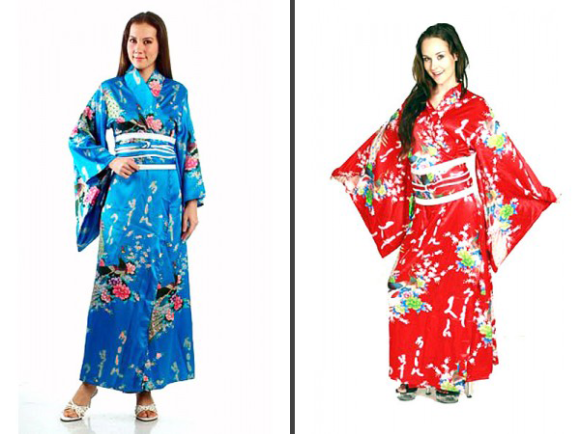
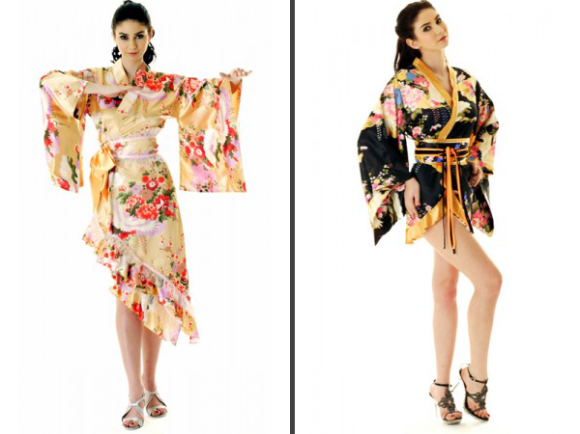
 Japanese company creates new “Kimono Pyjamas” designed to be worn indoors and outdoors
Japanese company creates new “Kimono Pyjamas” designed to be worn indoors and outdoors Reveal your inner fashion samurai with traditional clothes for the modern world
Reveal your inner fashion samurai with traditional clothes for the modern world Pokémon summer kimono arriving in stores just in time for festival season
Pokémon summer kimono arriving in stores just in time for festival season Yukata summer kimono separates allow you to mix and match traditional outfits with everyday wear
Yukata summer kimono separates allow you to mix and match traditional outfits with everyday wear Japanese cosplay gets a western twist with new Taisho Roman kimono outfits 【Photos】
Japanese cosplay gets a western twist with new Taisho Roman kimono outfits 【Photos】 7-Eleven Japan’s ramen-cooking robot whipped us up a bowl of noodles【Taste test】
7-Eleven Japan’s ramen-cooking robot whipped us up a bowl of noodles【Taste test】 Is it rude to sing along at concerts in Japan? We ask a pro musician for his take
Is it rude to sing along at concerts in Japan? We ask a pro musician for his take What can 3,000 yen get you at a Japanese hamburger chain? We find out
What can 3,000 yen get you at a Japanese hamburger chain? We find out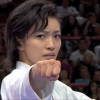 5 Japanese women who can kick your ass (in martial arts)【Women in Japan Series】
5 Japanese women who can kick your ass (in martial arts)【Women in Japan Series】 7-Eleven Japan starts new temporary luggage storage service in over 300 branches
7-Eleven Japan starts new temporary luggage storage service in over 300 branches Beyond fruit sandwiches — Japan has cake sandwiches too!【Taste test】
Beyond fruit sandwiches — Japan has cake sandwiches too!【Taste test】 Oodles of noodles! Udon chain pays homage to all 47 prefectures of Japan with 47 dishes【Photos】
Oodles of noodles! Udon chain pays homage to all 47 prefectures of Japan with 47 dishes【Photos】 Studio Ghibli releases new Spirited Away kami collection
Studio Ghibli releases new Spirited Away kami collection Tokyo changes age limit for kids going into opposite sex’s bath at hot springs and sento
Tokyo changes age limit for kids going into opposite sex’s bath at hot springs and sento Starbucks Japan’s Lucky Bag #3: A fukubukuro surprise we weren’t expecting
Starbucks Japan’s Lucky Bag #3: A fukubukuro surprise we weren’t expecting Disillusionment at Tsukiji’s tourist-target prices led us to a great ramen restaurant in Tokyo
Disillusionment at Tsukiji’s tourist-target prices led us to a great ramen restaurant in Tokyo Starbucks teams up with 166-year-old Kyoto doll maker for Year of the Horse decorations【Photos】
Starbucks teams up with 166-year-old Kyoto doll maker for Year of the Horse decorations【Photos】 Japan may add Japanese language proficiency, lifestyle classes to permanent foreign resident requirements
Japan may add Japanese language proficiency, lifestyle classes to permanent foreign resident requirements Starbucks Japan releases new zodiac chilled cup drink for 2026
Starbucks Japan releases new zodiac chilled cup drink for 2026 Lacquerware supplier to emperor of Japan and Pokémon team up for new tableware
Lacquerware supplier to emperor of Japan and Pokémon team up for new tableware Tokyo’s Tsukiji sushi neighborhood asks tour groups to stay away for the rest of the month
Tokyo’s Tsukiji sushi neighborhood asks tour groups to stay away for the rest of the month Is this the most relaxing Starbucks in Japan?
Is this the most relaxing Starbucks in Japan? Starbucks on a Shinkansen bullet train platform: 6 tips for using the automated store in Japan
Starbucks on a Shinkansen bullet train platform: 6 tips for using the automated store in Japan Street Fighter Hadouken Churros to be launched and eaten in Tokyo, Okami pudding on offer too
Street Fighter Hadouken Churros to be launched and eaten in Tokyo, Okami pudding on offer too Japan’s human washing machines will go on sale to general public, demos to be held in Tokyo
Japan’s human washing machines will go on sale to general public, demos to be held in Tokyo Japanese train company is letting fans buy its actual ticket gates for their homes
Japanese train company is letting fans buy its actual ticket gates for their homes Tokyo considering law requiring more trash cans following litter increase in heavily touristed area
Tokyo considering law requiring more trash cans following litter increase in heavily touristed area Nintendo’s Kirby now delivering orders at Kura Sushi restaurants, but not in Japan
Nintendo’s Kirby now delivering orders at Kura Sushi restaurants, but not in Japan Tokyo event lets you travel back in time, for free, to celebrate 100 years since Showa era start
Tokyo event lets you travel back in time, for free, to celebrate 100 years since Showa era start Sanrio theme park in Japan announces plans to expand into a Sanrio resort
Sanrio theme park in Japan announces plans to expand into a Sanrio resort Survey asks foreign tourists what bothered them in Japan, more than half gave same answer
Survey asks foreign tourists what bothered them in Japan, more than half gave same answer Japan’s deadliest food claims more victims, but why do people keep eating it for New Year’s?
Japan’s deadliest food claims more victims, but why do people keep eating it for New Year’s? We deeply regret going into this tunnel on our walk in the mountains of Japan
We deeply regret going into this tunnel on our walk in the mountains of Japan Studio Ghibli releases Kodama forest spirits from Princess Mononoke to light up your home
Studio Ghibli releases Kodama forest spirits from Princess Mononoke to light up your home Major Japanese hotel chain says reservations via overseas booking sites may not be valid
Major Japanese hotel chain says reservations via overseas booking sites may not be valid Put sesame oil in your coffee? Japanese maker says it’s the best way to start your day【Taste test】
Put sesame oil in your coffee? Japanese maker says it’s the best way to start your day【Taste test】 The top 10 annoying foreign tourist behaviors on trains, as chosen by Japanese people【Survey】
The top 10 annoying foreign tourist behaviors on trains, as chosen by Japanese people【Survey】 No more using real katana for tourism activities, Japan’s National Police Agency says
No more using real katana for tourism activities, Japan’s National Police Agency says Starbucks Japan reveals new sakura drinkware collection, inspired by evening cherry blossoms
Starbucks Japan reveals new sakura drinkware collection, inspired by evening cherry blossoms New Hello Kitty and friends summer kimono are perfect for Sanrio-loving parents, kids, and sisters
New Hello Kitty and friends summer kimono are perfect for Sanrio-loving parents, kids, and sisters My summer kimono Totoro! Ghibli mascot and Kiki co-star grace beautiful anime yukata【Photos】
My summer kimono Totoro! Ghibli mascot and Kiki co-star grace beautiful anime yukata【Photos】 Cardcaptor Sakura summer kimono lets you keep enjoying Sakura after the end of spring
Cardcaptor Sakura summer kimono lets you keep enjoying Sakura after the end of spring Weaving history, art and innovation together in a new range of Japanese yukata
Weaving history, art and innovation together in a new range of Japanese yukata Ariel and Jasmine star in Disney princess pseudo-kimono line from Japanese fashion brand【Photos】
Ariel and Jasmine star in Disney princess pseudo-kimono line from Japanese fashion brand【Photos】 New Disney summer kimono are beautifully cute and require no sash tying【Photos】
New Disney summer kimono are beautifully cute and require no sash tying【Photos】 This Tokyo kimono and Tokyo Tower-view cafe experience will keep you cool in more ways than one
This Tokyo kimono and Tokyo Tower-view cafe experience will keep you cool in more ways than one Beautiful, spongy soft modern Japanese sandals give you geta style without the traditional pain
Beautiful, spongy soft modern Japanese sandals give you geta style without the traditional pain Old West meets Far East with the denim kimono and samue
Old West meets Far East with the denim kimono and samue Super Mario kimono, Bowser underwear part of gigantic Nintendo/Japanese fashion brand collab
Super Mario kimono, Bowser underwear part of gigantic Nintendo/Japanese fashion brand collab Tokyo hotel offers a cool summer deal for the ladies, including a kimono that’s yours to keep
Tokyo hotel offers a cool summer deal for the ladies, including a kimono that’s yours to keep Experience your own “miracle romance” in one of these Sailor Moon summer kimono sets
Experience your own “miracle romance” in one of these Sailor Moon summer kimono sets Kimono to keep, dressing service, unlimited beer, one of Japan’s best views all in one package
Kimono to keep, dressing service, unlimited beer, one of Japan’s best views all in one package Hello Kitty dances the traditional Bon Odori dance on new Japanese summer kimono
Hello Kitty dances the traditional Bon Odori dance on new Japanese summer kimono How to tie a women’s summer kimono sash 【Video】
How to tie a women’s summer kimono sash 【Video】 What’s a furisode kimono without sleeves? An incredibly elegant wedding dress【Photos】
What’s a furisode kimono without sleeves? An incredibly elegant wedding dress【Photos】
Leave a Reply